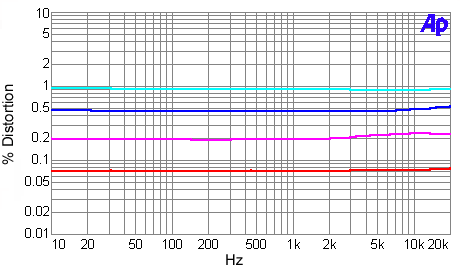December 2003
Blue Circle
Audio BC28 Stereo Amplifier: Measurements
All amplifier measurements are performed
independently by BHK Labs. Please click to learn
more about how we test amplifiers there. All measurement data and graphical
information displayed below are the property of SoundStage! and Schneider
Publishing Inc. Reproduction in any format is not permitted.
- Measurements were made with 120V AC line voltage.
- Power output and distortion plotted with both channels
driven.
- Gain: 19.2x, 25.7dB.
- Output noise, 8-ohm load, unbalanced input, 1k-ohm input
termination: wideband 0.363mV, -77.8dBW; A weighted 0.054mV, -94.4dBW.
- AC line current draw at idle: 0.72A.
- Output impedance at 50Hz: 0.16 ohms.
- This amplifier does not invert polarity.
Power output with 1kHz test signal
- 8-ohm load at 1% THD: 127W
- 4-ohm load at 1% THD: 219W
General
The Blue Circle BC28 is a hybrid design utilizing a
twin-triode tube for the front end and a solid-state output stage. This output stage is
most unusual in that it utilizes four TO-3 transistor-sized devices with four-pin
connections in addition to the case for each of these devices. These are most likely some
kind of power op amp. It appears that there are two parallel banks of two of these devices
for each output channel. Further, the interconnection of these devices produces a bridged
output signal with two phases of opposite polarity in respect to signal ground from the
single-ended drive out of the tube front end.
Chart 1 shows the frequency response of the amp with
varying loads. As can be seen, this unit has a very high frequency rise in response, most
likely leading to a peak in the response beyond the 200kHz limit of the chart. Also seen
is a reasonably low output impedance, as evidenced by the close spacing between the open
circuit and loaded curves. The variation in response with the NHT dummy speaker load is of
the order of +0.1dB,-0.15dB -- close to being audibly inconsequential. Chart 2 illustrates
how total harmonic distortion plus noise versus power varies for 1kHz and SMPTE IM test
signals and amplifier output load. As can be seen, attainable power is greater for the
4-ohm load as is usual for most power amplifiers. Total harmonic distortion plus noise as
a function of frequency at several different power levels is plotted in Chart 3. Of note
is the very rare but desirable characteristic of almost perfect constant amount of
distortion as a function of frequency. Damping factor versus frequency is shown in Chart
4. As with the harmonic distortion versus frequency, this damping factor is quite constant
with frequency. A spectrum of the harmonic distortion and noise residue is plotted in
Chart 5 for a 10W 1kHz signal into a 4-ohm load. With 8-ohm loading at the 10W level, the
distortion spectrum is more complex and with a higher amount of higher harmonics past the
second harmonic. Although the overall hum level is quite low for this amp, the AC line
harmonic series is fairly complex containing both even and odd harmonics of the 60Hz line
frequency.
| Chart 1
- Frequency Response of Output Voltage as a Function of Output Loading |

Magenta line: open circuit
Red line: 8-ohm load
Blue line: 4-ohm load
Cyan line: NHT dummy-speaker load
| Chart 2 - Distortion as a Function
of Power Output and Output Loading |

(line up at 50W to determine lines)
Top line: 8-ohm SMPTE IM
Second line: 4-ohm SMPTE IM
Third line: 8-ohm THD+N
Bottom line: 4-ohm THD+N
| Chart 3 - Distortion
as a Function of Power Output and Frequency |

4-ohm output loading
Cyan line: 200W
Blue line: 60W
Magenta line: 10W
Red line: 1W
| Chart 4 - Damping Factor
as a Function of Frequency |

Damping factor = output impedance divided into 8
| Chart 5 - Distortion and
Noise Spectrum |

1kHz signal at 10W into an 4-ohm load
|
![[SoundStage!]](../titles/sslogo3.gif) Home Audio
Home Audio ![[SoundStage!]](../titles/sslogo3.gif) All Contents
All Contents



